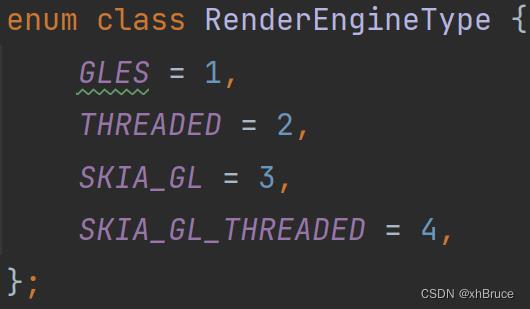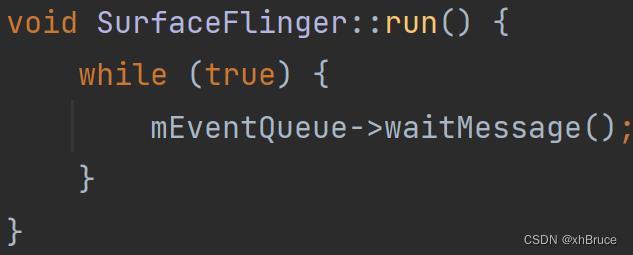SurfaceFlinger启动-Android12
Posted xhBruce
tags:
篇首语:本文由小常识网(cha138.com)小编为大家整理,主要介绍了SurfaceFlinger启动-Android12相关的知识,希望对你有一定的参考价值。
SurfaceFlinger启动-android12
android12-release
1. surfaceflinger.rc文件
由init进程所启动的守护进程,在init.rc中该服务如下surfaceflinger.rc文件
SurfaceFlinger进程名:surfaceflinger,
bin文件:/system/bin/surfaceflinger
对应启动入口:frameworks/native/services/surfaceflinger/main_surfaceflinger.cpp
frameworks/native/services/surfaceflinger/surfaceflinger.rc
service surfaceflinger /system/bin/surfaceflinger
class core animation
user system
group graphics drmrpc readproc
capabilities SYS_NICE
onrestart restart zygote
task_profiles HighPerformance
socket pdx/system/vr/display/client stream 0666 system graphics u:object_r:pdx_display_client_endpoint_socket:s0
socket pdx/system/vr/display/manager stream 0666 system graphics u:object_r:pdx_display_manager_endpoint_socket:s0
socket pdx/system/vr/display/vsync stream 0666 system graphics u:object_r:pdx_display_vsync_endpoint_socket:s0
main_surfaceflinger.cpp启动入口代码:
hardware::configureRpcThreadpool(1, false)设置当前进程用于hwbinder通信的最大线程数(#include <hidl/HidlTransportSupport.h>)- 启动 Gralloc 服务startGraphicsAllocatorService();HIDL直通式
hardware::registerPassthroughServiceImplementation<android::hardware::graphics::allocator::V2_0::IAllocator>()ProcessState::self()->setThreadPoolMaxThreadCount(4)设定surfaceflinger进程的binder线程池个数上限为4,并启动binder线程池ps->startThreadPool()surfaceflinger::createSurfaceFlinger()创建SurfaceFlinger对象- 设置surfaceflinger进程为高优先级
setpriority(PRIO_PROCESS, 0, PRIORITY_URGENT_DISPLAY)以及前台调度策略set_sched_policy(0, SP_FOREGROUND);flinger->init()初始化SurfaceFlingersm->addService(String16(SurfaceFlinger::getServiceName()), flinger,...)将"SurfaceFlinger"服务注册到binder通信的ServiceManager;startDisplayService()启动;HIDL定义接口frameworks/hardware/interfaces/displayservice/1.0/IDisplayService.halflinger->run()在当前主线程执行SurfaceFlinger的run方法
frameworks/native/services/surfaceflinger/main_surfaceflinger.cpp
int main(int, char**)
signal(SIGPIPE, SIG_IGN);
hardware::configureRpcThreadpool(1 /* maxThreads */,
false /* callerWillJoin */);
startGraphicsAllocatorService();
// When SF is launched in its own process, limit the number of
// binder threads to 4.
ProcessState::self()->setThreadPoolMaxThreadCount(4);
// Set uclamp.min setting on all threads, maybe an overkill but we want
// to cover important threads like RenderEngine.
if (SurfaceFlinger::setSchedAttr(true) != NO_ERROR)
ALOGW("Couldn't set uclamp.min: %s\\n", strerror(errno));
// The binder threadpool we start will inherit sched policy and priority
// of (this) creating thread. We want the binder thread pool to have
// SCHED_FIFO policy and priority 1 (lowest RT priority)
// Once the pool is created we reset this thread's priority back to
// original.
int newPriority = 0;
int origPolicy = sched_getscheduler(0);
struct sched_param origSchedParam;
int errorInPriorityModification = sched_getparam(0, &origSchedParam);
if (errorInPriorityModification == 0)
int policy = SCHED_FIFO;
newPriority = sched_get_priority_min(policy);
struct sched_param param;
param.sched_priority = newPriority;
errorInPriorityModification = sched_setscheduler(0, policy, ¶m);
// start the thread pool
sp<ProcessState> ps(ProcessState::self());
ps->startThreadPool();
// Reset current thread's policy and priority
if (errorInPriorityModification == 0)
errorInPriorityModification = sched_setscheduler(0, origPolicy, &origSchedParam);
else
ALOGE("Failed to set SurfaceFlinger binder threadpool priority to SCHED_FIFO");
// instantiate surfaceflinger
sp<SurfaceFlinger> flinger = surfaceflinger::createSurfaceFlinger();
// Set the minimum policy of surfaceflinger node to be SCHED_FIFO.
// So any thread with policy/priority lower than SCHED_FIFO, 1, will run
// at least with SCHED_FIFO policy and priority 1.
if (errorInPriorityModification == 0)
flinger->setMinSchedulerPolicy(SCHED_FIFO, newPriority);
setpriority(PRIO_PROCESS, 0, PRIORITY_URGENT_DISPLAY);
set_sched_policy(0, SP_FOREGROUND);
// Put most SurfaceFlinger threads in the system-background cpuset
// Keeps us from unnecessarily using big cores
// Do this after the binder thread pool init
if (cpusets_enabled()) set_cpuset_policy(0, SP_SYSTEM);
// initialize before clients can connect
flinger->init();
// publish surface flinger
sp<IServiceManager> sm(defaultServiceManager());
sm->addService(String16(SurfaceFlinger::getServiceName()), flinger, false,
IServiceManager::DUMP_FLAG_PRIORITY_CRITICAL | IServiceManager::DUMP_FLAG_PROTO);
startDisplayService(); // dependency on SF getting registered above
if (SurfaceFlinger::setSchedFifo(true) != NO_ERROR)
ALOGW("Couldn't set to SCHED_FIFO: %s", strerror(errno));
// run surface flinger in this thread
flinger->run();
return 0;
2. SurfaceFlinger初始化
SurfaceFlinger继承于BnSurfaceComposer,IBinder::DeathRecipient等;new SurfaceFlinger()初始化sp强指针首次被引用时则执行onFirstRef()
SurfaceFlingerFactory.cpp/SurfaceFlingerDefaultFactory.cpp各种创建mSetInputWindowsListener = new SetInputWindowsListener([&]() setInputWindowsFinished(); )继承os::BnSetInputWindowsListener,AIDL定义接口frameworks/native/libs/input/android/os/ISetInputWindowsListener.aidl
frameworks/native/services/surfaceflinger/SurfaceFlinger.cpp
SurfaceFlinger::SurfaceFlinger(Factory& factory, SkipInitializationTag)
: mFactory(factory),
mInterceptor(mFactory.createSurfaceInterceptor()),
mTimeStats(std::make_shared<impl::TimeStats>()),
mFrameTracer(mFactory.createFrameTracer()),
mFrameTimeline(mFactory.createFrameTimeline(mTimeStats, getpid())),
mEventQueue(mFactory.createMessageQueue()),
mCompositionEngine(mFactory.createCompositionEngine()),
mHwcServiceName(base::GetProperty("debug.sf.hwc_service_name"s, "default"s)),
mTunnelModeEnabledReporter(new TunnelModeEnabledReporter()),
mInternalDisplayDensity(getDensityFromProperty("ro.sf.lcd_density", true)),
mEmulatedDisplayDensity(getDensityFromProperty("qemu.sf.lcd_density", false)),
mPowerAdvisor(*this)
ALOGI("Using HWComposer service: %s", mHwcServiceName.c_str());
mSetInputWindowsListener = new SetInputWindowsListener([&]() setInputWindowsFinished(); );
SurfaceFlinger::SurfaceFlinger(Factory& factory) : SurfaceFlinger(factory, SkipInitialization)
// ... ...
2.1 onFirstRef 创建Handler并初始化
创建 Handler/Looper 并初始化
void SurfaceFlinger::onFirstRef()
mEventQueue->init(this);
/frameworks/native/services/surfaceflinger/Scheduler/MessageQueue.cpp
void MessageQueue::init(const sp<SurfaceFlinger>& flinger)
mFlinger = flinger;
mLooper = new Looper(true);
mHandler = new Handler(*this);
2.2 SurfaceFlinger::init()
renderengine::RenderEngine::create()获取RenderEngine引擎;
- 两类引擎
GLESRenderEngine、SkiaGLRenderEngine,RenderEngineThreaded对应相应异步线程;RenderEngineCreationArgs参数配置,其中默认RenderEngineType::SKIA_GL_THREADED类型,即RenderEngineThreaded::create(SkiaGLRenderEngine::create(skiaArgs),renderEngineType);- SkiaGLRenderEngine创建中
EGLDisplay display = eglGetDisplay(EGL_DEFAULT_DISPLAY)初始化EGL相关

getFactory().createHWComposer(mHwcServiceName)创建 HWComposerprocessDisplayHotplugEventsLocked()处理任何初始热插拔和显示更改结果
processDisplayChanged()/processDisplayAdded()处理显示更改结果- 其中
initScheduler(state)创建app、appsf的链接mAppConnectionHandle、mSfConnectionHandle,并启动对应EventThread线程
initializeDisplays()初始化显示设备mStartPropertySetThread->Start()在线程中设置property_set("ctl.start", "bootanim")启动开机动画
void SurfaceFlinger::init()
ALOGI( "SurfaceFlinger's main thread ready to run. "
"Initializing graphics H/W...");
Mutex::Autolock _l(mStateLock);
// Get a RenderEngine for the given display / config (can't fail)
// TODO(b/77156734): We need to stop casting and use HAL types when possible.
// Sending maxFrameBufferAcquiredBuffers as the cache size is tightly tuned to single-display.
mCompositionEngine->setRenderEngine(renderengine::RenderEngine::create(
renderengine::RenderEngineCreationArgs::Builder()
.setPixelFormat(static_cast<int32_t>(defaultCompositionPixelFormat))
.setImageCacheSize(maxFrameBufferAcquiredBuffers)
.setUseColorManagerment(useColorManagement)
.setEnableProtectedContext(enable_protected_contents(false))
.setPrecacheToneMapperShaderOnly(false)
.setSupportsBackgroundBlur(mSupportsBlur)
.setContextPriority(
useContextPriority
? renderengine::RenderEngine::ContextPriority::REALTIME
: renderengine::RenderEngine::ContextPriority::MEDIUM)
.build()));
// Set SF main policy after initializing RenderEngine which has its own policy.
if (!SetTaskProfiles(0, "SFMainPolicy"))
ALOGW("Failed to set main task profile");
mCompositionEngine->setTimeStats(mTimeStats);
mCompositionEngine->setHwComposer(getFactory().createHWComposer(mHwcServiceName));
mCompositionEngine->getHwComposer().setCallback(this);
ClientCache::getInstance().setRenderEngine(&getRenderEngine());
if (base::GetBoolProperty("debug.sf.enable_hwc_vds"s, false))
enableHalVirtualDisplays(true);
// Process any initial hotplug and resulting display changes.
processDisplayHotplugEventsLocked();
const auto display = getDefaultDisplayDeviceLocked();
LOG_ALWAYS_FATAL_IF(!display, "Missing internal display after registering composer callback.");
const auto displayId = display->getPhysicalId();
LOG_ALWAYS_FATAL_IF(!getHwComposer().isConnected(displayId),
"Internal display is disconnected.");
// initialize our drawing state
mDrawingState = mCurrentState;
// set initial conditions (e.g. unblank default device)
initializeDisplays();
mPowerAdvisor.init();
char primeShaderCache[PROPERTY_VALUE_MAX];
property_get("service.sf.prime_shader_cache", primeShaderCache, "1");
if (atoi(primeShaderCache))
if (setSchedFifo(false) != NO_ERROR)
ALOGW("Can't set SCHED_OTHER for primeCache");
mRenderEnginePrimeCacheFuture = getRenderEngine().primeCache();
if (setSchedFifo(true) != NO_ERROR)
ALOGW("Can't set SCHED_OTHER for primeCache");
getRenderEngine().onPrimaryDisplaySizeChanged(display->getSize());
// Inform native graphics APIs whether the present timestamp is supported:
const bool presentFenceReliable =
!getHwComposer().hasCapability(hal::Capability::PRESENT_FENCE_IS_NOT_RELIABLE);
mStartPropertySetThread = getFactory().createStartPropertySetThread(presentFenceReliable);
if (mStartPropertySetThread->Start() != NO_ERROR)
ALOGE("Run StartPropertySetThread failed!");
ALOGV("Done initializing");
3. SurfaceFlinger::run()
不断循环地等待事件


4. 简要时序图

以上是关于SurfaceFlinger启动-Android12的主要内容,如果未能解决你的问题,请参考以下文章

